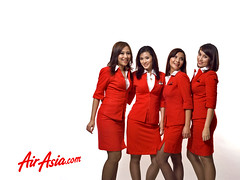Due to its weak performance in 2008, the shareholders of AirAsia had been worried about its gearing and coverage ratios.
This article is just a simple analysis on AirAsia's 2008 cashflow, which is an important measure of the company's ability in servicing its debts.
According to its audited account, AirAsia's cashflow from operation in 2008 is negative RM 416 million. This number, however, is what we get after charging the unwinding loss on derivatives. Seeing that the huge cash outflow of this unwinding process is not neccesarily to be recurring, we should exclude them from our analysis so that we can get a more accurate picture on AirAsia's real performance.
How much cash had AirAsia actually paid in the unwinding transactions? According to its report, the total unwinding loss incurred is RM 1.1 billion. The loss is allocated and borne by three entities of AirAsia:
- AirAsia Malaysia: RM 679 milion
- Thai AirAsia: RM 222 million
- Indonesia AirAsia: RM 207 million.
Among these losses, only the RM 679 million is reflected in AirAsia's income statement. I believe, however, that the cash outflow of RM 1.1 bllion is all paid from within AirAsia. This is because the two oversea entities have no enough cash to settle those transations -- their operation are still in loss position, and their equities are negative. And from the statements of AirAsia, we can see that more than RM 500 million of cash was injected into these entities by AirAsia in 2008.

Thus, instead of RM 679 milion, the total amount of RM 1.1 billion should be used for our adjustment on AirAsia's cashflow. After the first adjustment, the operational cashflow of AirAsia had become a positive RM 691 million.
Then, due to the reason discussed in my previous post (regarding the recurring nature of the fuel-hedging transactions), I'll charge back a cash outflow of RM136 million (equal to 20% of RM679 million) into AirAsia's cashflow account. After this second adjustment, AirAsia's operational cashflow of 2008 would be a positive RM 555 million.
* This figure is from the perspective of AirAsia company only. Because I can't get the information on the cashflows of TAA and IAA, analysis from the level of whole AirAsia Group can't be done.
Compared to the company's cash outflow on interest (RM 240 milion) and repayment of borrowing (RM 301 million), the operational cashflow can be considered as strong, and its cashflow ratios is within my comfort zone.
However, this cashflow performance is still below my initial expection. In 2009, I hope that AirAsia can make a huge improvement, generating an operational cashflow of no less than RM 1 billion.

No comments:
Post a Comment